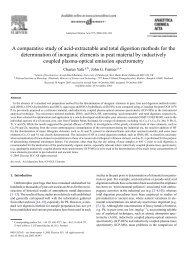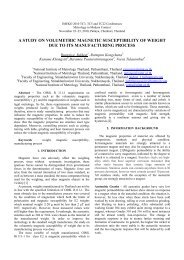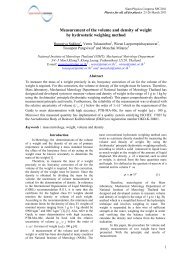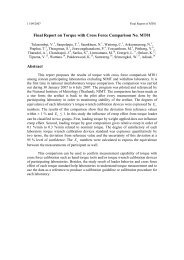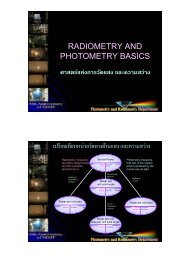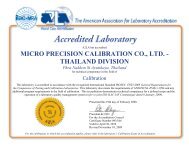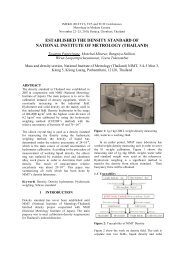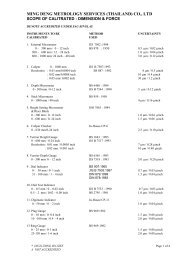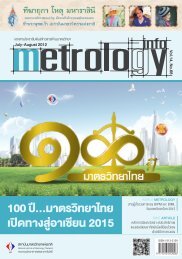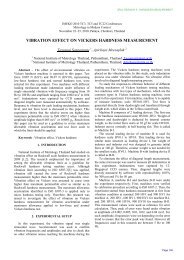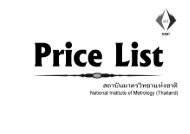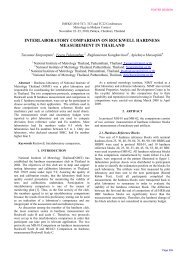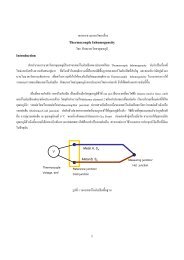Comparison of Calibration Methods for Radiation Thermomemeter ...
Comparison of Calibration Methods for Radiation Thermomemeter ...
Comparison of Calibration Methods for Radiation Thermomemeter ...
You also want an ePaper? Increase the reach of your titles
YUMPU automatically turns print PDFs into web optimized ePapers that Google loves.
<strong>Comparison</strong> <strong>of</strong> <strong>Calibration</strong> <strong>Methods</strong> <strong>for</strong> <strong>Radiation</strong> <strong>Thermomemeter</strong> below the<br />
Freezing Point <strong>of</strong> Copper at NIMT<br />
P. Wongnut 1,2 , T. Keawprasert 1 , U. Norranim 1<br />
1 National Institute <strong>of</strong> Metrology Thailand, 3/4-5, Klong 5, Klong Luang, Pathumthani 12120, Thailand<br />
2 To whom correspondence should be addressed. E-mail: phichet@nimt.or.th<br />
NIMT has established the calibration facility <strong>for</strong><br />
radiation thermometers in the temperature range from<br />
o<br />
o<br />
157 C to 1085 C by comparison with fixed-points. To<br />
determine the radiance temperature by integration<br />
scale, a double monochromator-based facility has<br />
been set up <strong>for</strong> the relative spectral responsivity<br />
calibration over the region from 250 to 1200 nm. Both<br />
calibration methods use Sakuma-Hattori equation to<br />
fit the measurement results. The spectral integration<br />
temperature scale is compared with the radiance scale<br />
obtained by using the fixed-point blackbody sources<br />
INTRODUCTION<br />
At National Institute <strong>of</strong> Metrology Thailand (NIMT),<br />
the calibration <strong>of</strong> standard radiation thermometers was<br />
normally based on a series <strong>of</strong> fixed-point blackbody<br />
sources with the temperature range from the freezing<br />
point <strong>of</strong> indium (156.5985 o C) to copper (1084.62 o C),<br />
without their spectral responsivity measurement [1].<br />
Recently a monochromator facility has been set<br />
up to calibrate the spectral responsivity <strong>of</strong> standard<br />
radiation thermometers <strong>of</strong> NIMT. Such a 0.65 μm<br />
standard radiation thermometer was calibrated using a<br />
copper point blackbody source in combination with a<br />
spectral responsivity measurement and a non-linearity<br />
measurement, and then it can be used to realize the<br />
ITS-90 scale up to 2,500 o C.<br />
Likely, in case <strong>of</strong> a 0.9 μm standard radiation<br />
thermometer and a 1.6 μm standard radiation<br />
thermometer, it is able to determine the independent<br />
scale with the spectral responsivity calibration to<br />
verify the scale from the multi fixed-points method<br />
[2]. In this article, both <strong>of</strong> calibration methods are<br />
per<strong>for</strong>med <strong>for</strong> the 0.9 μm standard radiation<br />
thermometer to compare the integration scale with the<br />
multi fixed-point temperature scale at the fixed-point<br />
temperatures in the range from Zn point to Cu point.<br />
CALIBRATION METHODS<br />
Fixed-Point Method<br />
A 0.9 μm standard radiation thermometer is<br />
calibrated with the fixed-points from zinc (419.527◦C)<br />
to copper (1084.62◦C). Each fixed-point blackbody<br />
has an aperture <strong>of</strong> 6 mm diameter and an effective<br />
emissivity <strong>of</strong> 0.9995±0.0005.<br />
All calibration data points <strong>of</strong> each artefact are<br />
fitted with the Plank version <strong>of</strong> Sakuma-Hattori<br />
equation. The residual errors at any fixed-points <strong>for</strong><br />
all radiation thermometers are less than ±5 mK.<br />
Spectral Responsivity Method<br />
The double-grating monochromator with 250 focal<br />
length covers the spectral range from 250 nm to<br />
1200 nm by using a diffraction grating with 1200<br />
lines/mm with a 750 nm blaze wavelength. A<br />
mercury lamp is used to calibrate and initialize the<br />
wavelength scale <strong>of</strong> the monochromator. There<strong>for</strong>e,<br />
its accuracy in the wavelength scale is better than<br />
0.1 nm. A standard Si photo diode, which absolute<br />
spectral irradiance is traceable to NMIJ, is directly<br />
compared to the radiation thermometer.<br />
For measurements, the spectral bandwidth <strong>of</strong> 1.0<br />
nm is per<strong>for</strong>med in the spectral bandpass <strong>of</strong> the<br />
radiation thermometer, and 10 nm in the blocking<br />
region. <strong>Calibration</strong> results <strong>of</strong> all standard radiation<br />
thermometers are shown in Fig. 1. The fine structure<br />
is investigated around the peak <strong>of</strong> spectral<br />
responsivity with the spectral bandwidth <strong>of</strong> 0.1 nm.<br />
Then an independent radiance temperature scale<br />
is realized by integrating the spectral responsivity<br />
R(λ) multiplied by the Planck function L(λ, T ),<br />
∫<br />
V ( T ) = a L(<br />
λ,<br />
T ) R(<br />
λ)<br />
dλ<br />
where the coefficient a was determined from signal<br />
at the silver or copper point. And the Sakuma-<br />
Hattori equation is used as the calibration relation.<br />
Relative Spectral Responsivity<br />
1.E+01<br />
1.E+00<br />
1.E-01<br />
1.E-02<br />
1.E-03<br />
1.E-04<br />
1.E-05<br />
1.E-06<br />
1.E-07<br />
400 500 600 700 800 900 1000 1100 1200<br />
Wavelength / nm<br />
650 nm radiation thermometer<br />
900 nm radiation thermometer<br />
Figure 1. Relative spectral responsivity <strong>of</strong> the standard<br />
radiation thermometers <strong>of</strong> NIMT.
DISCUSSION<br />
The combined uncertainty (k = 1) due to the fixedpoint<br />
blackbodies excluding drift is now 80 mK at Zn<br />
point to 100 mK at Cu point. Other sources <strong>of</strong> error<br />
due to the radiation thermometer such as size <strong>of</strong><br />
source effect, nonlinearity and gain ratio are not<br />
described in this article.<br />
In the measurements <strong>of</strong> spectral responsivity,<br />
relative integral errors in the bandpass are less than<br />
10 -4 <strong>for</strong> both 0.65 μm and 0.9 μm thermometers.<br />
Additionally the out-<strong>of</strong>-band responsivities <strong>of</strong> all<br />
thermometers are approximately 10 -5 . From the<br />
investigations in the fine structure, any interference<br />
effects are not found with the spectral bandwidth <strong>of</strong><br />
0.1 nm. That shows that all standard radiation<br />
thermometers have excellent optics systems which<br />
can eliminate the interference error. The relative<br />
uncertainties are 0.4 % and 0.5% <strong>for</strong> 0.65 μm and 0.9<br />
μm radiation thermometer respectively. The main<br />
component <strong>of</strong> uncertainty is due to the standard photo<br />
diode. However, with this relative uncertainty level,<br />
the uncertainty in temperature <strong>of</strong> the integration scale<br />
down to the Zn point is in the same level <strong>of</strong> the fixedpoint<br />
scale. More details <strong>for</strong> the uncertainty<br />
calculation is described in [3].<br />
For 0.9 μm radiation thermometer, the differences<br />
<strong>of</strong> radiance temperature with combined uncertainty<br />
between the fixed-point scale and the integral scale at<br />
the fixed-point temperatures are shown in Fig.2.<br />
While the same difference at the Ag point is 66 mK<br />
<strong>for</strong> 0.65 μm radiation thermometer.<br />
spectral responsivity. A 0.9 μm standard radiation<br />
thermometer is calibrated with fixed-points <strong>of</strong> Zn,<br />
Al, Ag and Cu to per<strong>for</strong>m its temperature scale. To<br />
verify the scale, an independent scale obtained from<br />
the integration <strong>of</strong> relative spectral responsivity and<br />
Planck’s law is realized. The maximum difference<br />
<strong>of</strong> both temperature scales is 0.71 ± 0.26 o C at the<br />
fixed-point temperature <strong>of</strong> Zinc.<br />
REFERENCES<br />
[1] F. Sakuma. and M. Kobayashi, in Proceeding <strong>of</strong>.<br />
TEMPMEKO 1997, 305-310, 1997.<br />
[2] H.J.Jung, in Proceedings <strong>of</strong> TEMPMEKO 1996, 235-<br />
244, 1997.<br />
[3] J. Hartmann and L.Werner, Int J Thermophys,<br />
DOI 10.1007/s10765-008-0383-3.<br />
0.8<br />
Difference from fixed-point scale<br />
0.4<br />
0.0<br />
-0.4<br />
-0.8<br />
-1.2<br />
400 600 800 1000 1200<br />
Fixed-point temperature / o C<br />
Figure 2. Differences <strong>of</strong> temperature at the 4 fixed-points<br />
CONCLUSION<br />
The double monochromator is set up to per<strong>for</strong>m the<br />
spectral responsivity calibration from 250 nm to 1200<br />
nm <strong>for</strong> standard radiation thermometers. A 0.65 μm<br />
standard radiation thermometer is calibrated with Ag<br />
or Cu fixed-point blackbody to extend its calibration<br />
range up to 2500 o C, combination with its relative



